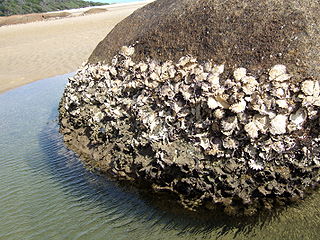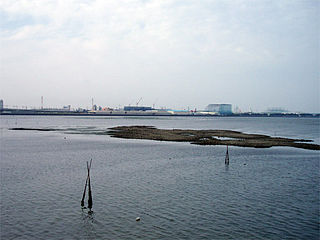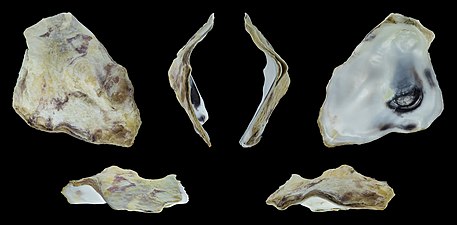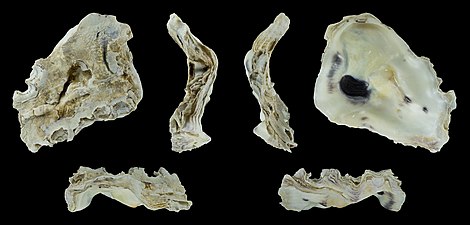
Mariculture or marine farming is a specialized branch of aquaculture involving the cultivation of marine organisms for food and other animal products, in enclosed sections of the open ocean, fish farms built on littoral waters, or in artificial tanks, ponds or raceways which are filled with seawater. An example of the latter is the farming of marine fish, including finfish and shellfish like prawns, or oysters and seaweed in saltwater ponds. Non-food products produced by mariculture include: fish meal, nutrient agar, jewellery, and cosmetics.

Oyster is the common name for a number of different families of salt-water bivalve molluscs that live in marine or brackish habitats. In some species, the valves are highly calcified, and many are somewhat irregular in shape. Many, but not all oysters, are in the superfamily Ostreoidea.
Broodstock, or broodfish, are a group of mature individuals used in aquaculture for breeding purposes. Broodstock can be a population of animals maintained in captivity as a source of replacement for, or enhancement of, seed and fry numbers. These are generally kept in ponds or tanks in which environmental conditions such as photoperiod, temperature and pH are controlled. Such populations often undergo conditioning to ensure maximum fry output. Broodstock can also be sourced from wild populations where they are harvested and held in maturation tanks before their seed is collected for grow-out to market size or the juveniles returned to the sea to supplement natural populations. This method, however, is subject to environmental conditions and can be unreliable seasonally, or annually. Broodstock management can improve seed quality and number through enhanced gonadal development and fecundity.
Hillarys is a northern coastal suburb of Perth, the capital city of Western Australia, in the local government area of the City of Joondalup. It is part of the Whitfords precinct, and is located 21 km north-northwest of Perth's central business district via Mitchell Freeway and Hepburn Avenue.

A fish hatchery is a place for artificial breeding, hatching, and rearing through the early life stages of animals—finfish and shellfish in particular. Hatcheries produce larval and juvenile fish, shellfish, and crustaceans, primarily to support the aquaculture industry where they are transferred to on-growing systems, such as fish farms, to reach harvest size. Some species that are commonly raised in hatcheries include Pacific oysters, shrimp, Indian prawns, salmon, tilapia and scallops.

The Pacific oyster, Japanese oyster, or Miyagi oyster, is an oyster native to the Pacific coast of Asia. It has become an introduced species in North America, Australia, Europe, and New Zealand.

Oyster farming is an aquaculture practice in which oysters are bred and raised mainly for their pearls, shells and inner organ tissue, which is eaten. Oyster farming was practiced by the ancient Romans as early as the 1st century BC on the Italian peninsula and later in Britain for export to Rome. The French oyster industry has relied on aquacultured oysters since the late 18th century.

Saccostrea glomerata is an oyster species belonging to the family Ostreidae.

Rock oysters are true oysters of the genus Saccostrea, belonging to the subfamily Saccostreinae of the family Ostreidae.

Aquaculture started to take off in New Zealand in the 1980s. It is dominated by mussels, oysters and salmon. In 2007, aquaculture generated about NZ$360 million in sales on an area of 7,700 hectares. $240 million was earned in exports.

Aquaculture in Australia is the country's fastest-growing primary industry, accounting for 34% of the total gross value of production of seafood. 10 species of fish are farmed in Australia, and production is dominated by southern bluefin tuna, Atlantic salmon and barramundi. Mud crabs have also been cultivated in Australia for many years, sometimes leading to over-exploitation. Traditionally, this aquaculture was limited to pearls, but since the early 1970s, there has been significant research and commercial development of other forms of aquaculture, including finfish, crustaceans, and molluscs.

Scallop aquaculture is the commercial activity of cultivating (farming) scallops until they reach a marketable size and can be sold as a consumer product. Wild juvenile scallops, or spat, were collected for growing in Japan as early as 1934. The first attempts to fully cultivate scallops in farm environments were not recorded until the 1950s and 1960s. Traditionally, fishing for wild scallops has been the preferred practice, since farming can be expensive. However worldwide declines in wild scallop populations have resulted in the growth of aquaculture. Globally the scallop aquaculture industry is now well established, with a reported annual production totalling over 1,200,000 metric tonnes from about 12 species. China and Japan account for about 90% of the reported production.

Oyster reef restoration refers to the reparation and reconstruction of degraded oyster reefs. Environmental changes, modern fishing practices, over harvesting, water pollution, and other factors, have resulted in damage, disease, and ultimately, a large decline in global population and prevalence of oyster habitats. Aside from ecological importance, oyster farming is an important industry in many regions around the world. Both natural and artificial materials have been used in efforts to increase population and regenerate reefs.

Saccostrea cucullata, the hooded oyster or Natal rock oyster, is a species of rock oyster found mainly in the Indo-Pacific Ocean.

Pteria sterna, or commonly known as the rainbow-lipped pearl oyster or the Pacific wing-oyster, is a species of marine bivalve mollusk in the family Pteriidae, the pearl oysters. This oyster can be found in shallow water along the tropical and subtropical Pacific coast of America, its range including Baja California, Mexico and northern Peru.

Magallana bilineata, commonly known as the Philippine cupped oyster or slipper oyster, is an economically important species of true oyster found abundantly in the western Pacific Ocean, from the Philippines to Tonga and Fiji. In 2020 an exotic population was discovered in north-east Australia. They grow attached to hard objects in brackish shallow intertidal or subtidal waters, at depths of 0 to 300 metres. They are cultured extensively in the Philippines, where annual landings can range from 11,700 to 18,300 tons. They are known as talaba or talabang tsinelas in Filipino to distinguish them from talabang kukong kabayo

Aquaculture in the United Kingdom is dominated by salmon farming, then by mussel production with trout being the third most important enterprise. Aquaculture in the United Kingdom represents a significant business for the UK, producing over 200,000 tonnes of fish whilst earning over £700 million in 2012 (€793 million).
















